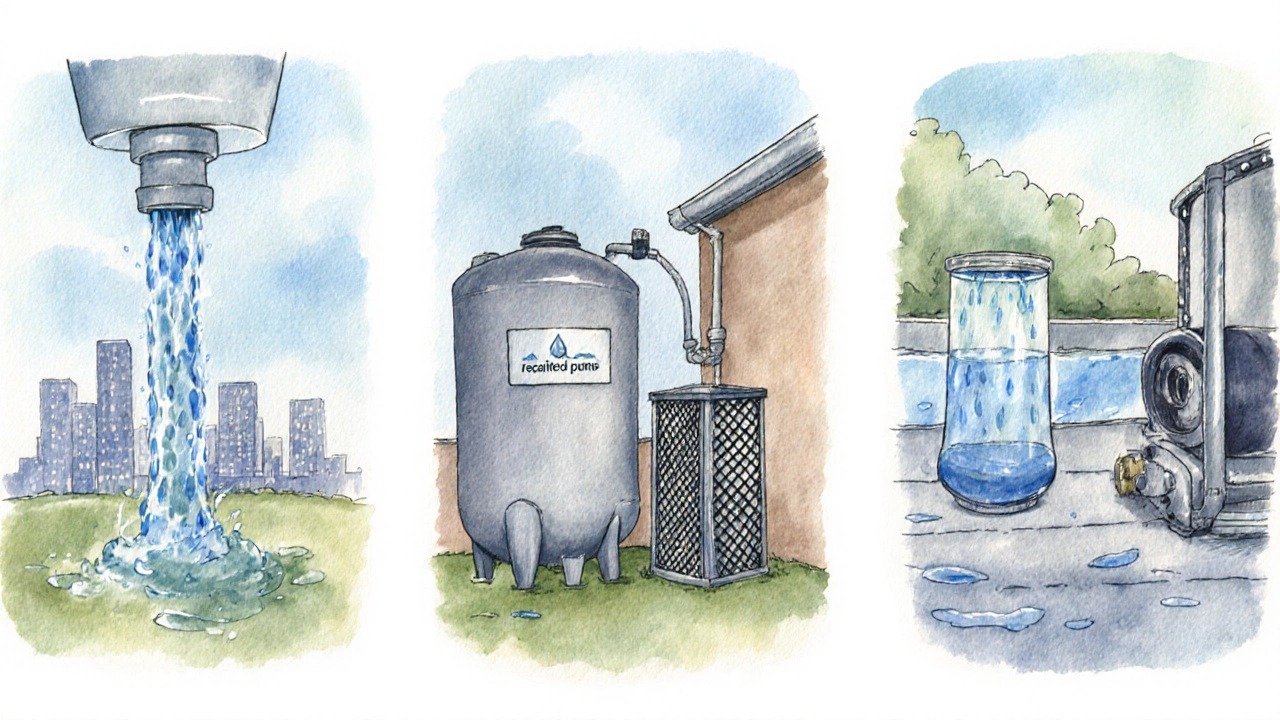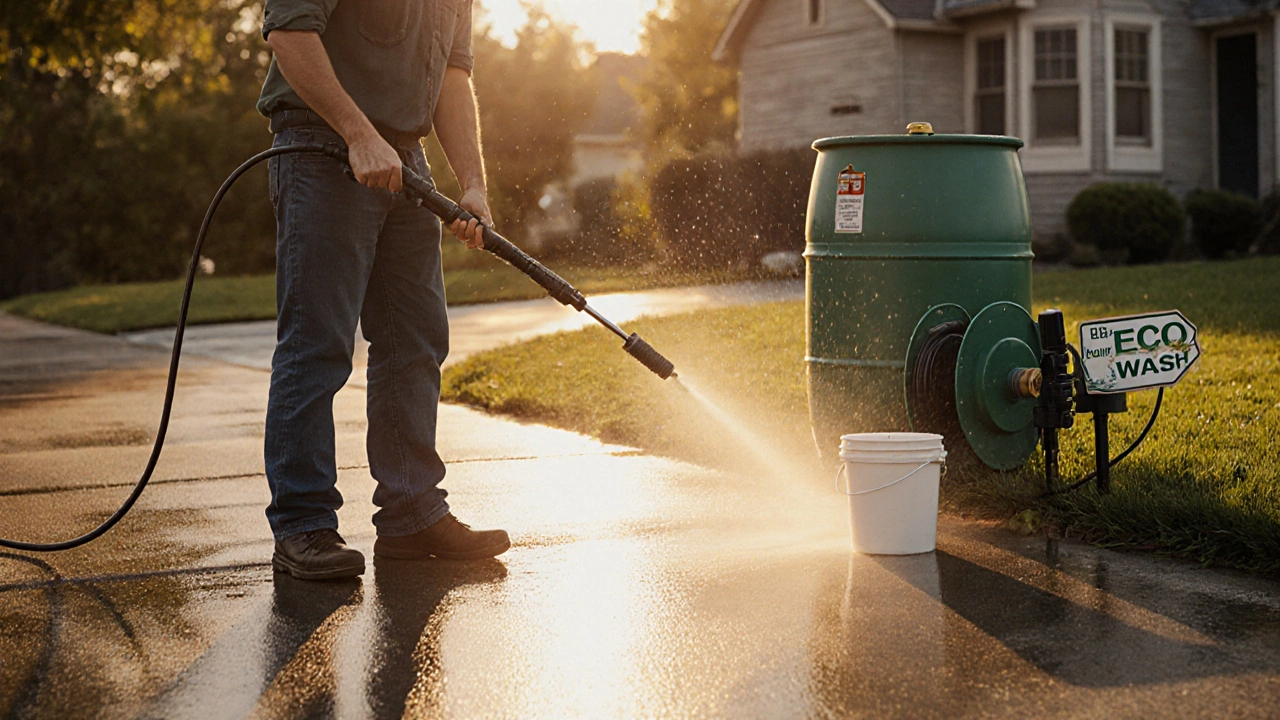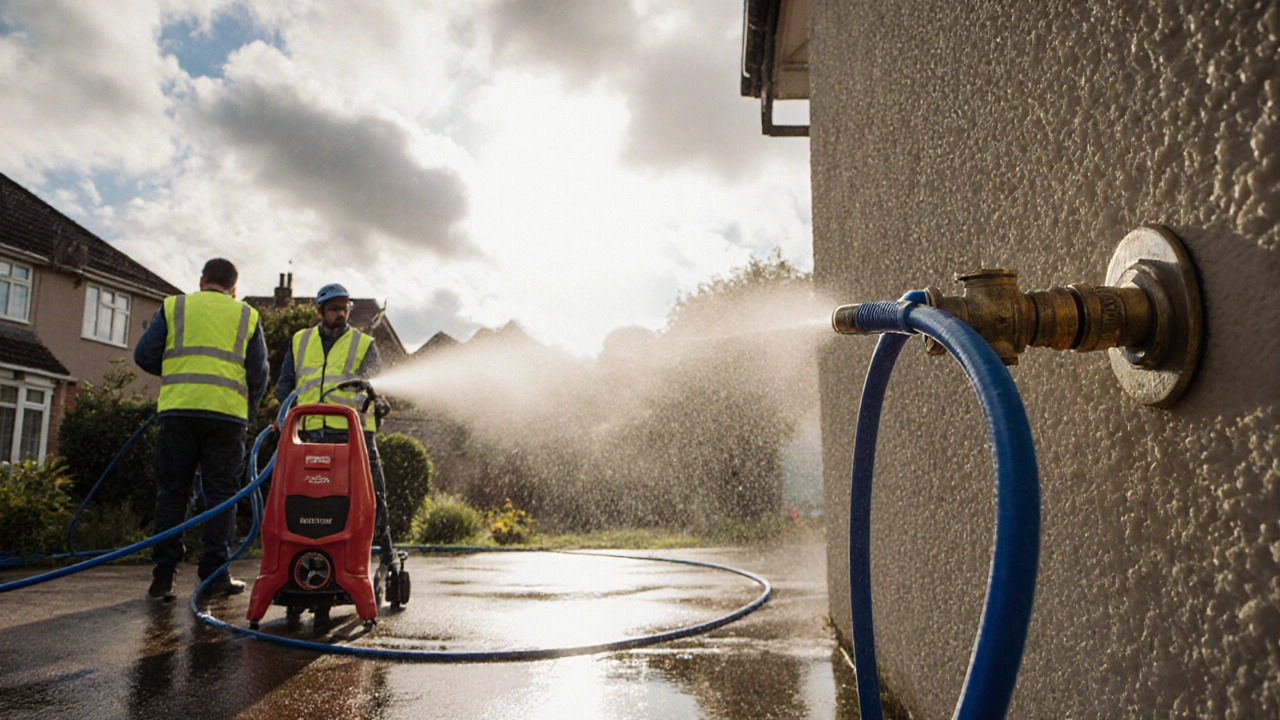Pressure Washing Water Calculator
Input Parameters
Results
Total Water Used
Enter your job details above to see results
Eco-Friendly Savings
With recirculating systems, you could save up to 70% water
Water Usage Comparison
Your job uses approximately 0 L water
This is equivalent to:
Ever wondered where the hose gets its liquid when a crew shows up to blast away grime? The short answer is: most pressure‑washing jobs pull water straight from the mains, but there are other options-reclaimed water, on‑site tanks, even dry‑ice blasting. Knowing the source matters for your pocket, the environment, and local regulations.
What is pressure washing?
Pressure washing is a cleaning method that uses a high‑pressure stream of water (or sometimes a cleaning solution) to remove dirt, mold, graffiti, and loose paint from surfaces such as driveways, decks, and building façades. The equipment typically consists of a motor‑driven pump, a high‑pressure hose, and a nozzle that concentrates the flow. Because the water is forced through a tiny opening, it can reach speeds up to 2,000psi, turning a simple stream into a powerful cleaning force.
Typical water sources for professional pressure washing
When you hire a contractor, the water they use usually comes from one of three places:
- Mains water - the municipal supply that feeds every household and business.
- Reclaimed or gray water - water collected from rain barrels, on‑site storage tanks, or treatment plants that is then reused for cleaning.
- Specialised low‑water systems - equipment that recirculates water through a filter, reducing the volume needed.
In the UK, the majority of small‑to‑medium jobs still rely on mains water because it’s readily available and the cost of setting up a reclaimed‑water system can be high. Larger commercial operators, especially those with environmental certifications, are more likely to invest in water‑recycling rigs.
UK regulations that affect water use in pressure washing
The Environment Agency oversees the discharge of wash‑off water into public sewers and surface water. Under the Water Environment (Water Quality) Regulations 2017, businesses must ensure that runoff does not contain harmful chemicals or excessive sediment that could pollute rivers or lakes.
At the same time, the Water Services Regulation Authority (Ofwat) encourages water‑saving practices across the sector. While there is no outright ban on using mains water for pressure washing, companies that repeatedly exceed reasonable consumption thresholds may face fines or be required to implement mitigation plans.
Key legal points to remember:
- Any chemicals added to the water must be approved for discharge.
- Runoff that enters the public drainage system must be filtered to remove solids.
- Large‑scale projects (over 5m³ per hour) often need a permit specifying allowable flow rates.

Environmental impact of high water consumption
Pressure washing can waste a surprising amount of water. A typical 1,500psi machine uses between 0.5 and 1.5gallons (≈2-6litres) per minute. A two‑hour driveway cleaning can therefore consume up to 180litres - roughly the same as a 10‑person shower.
Beyond volume, the temperature of the water matters. Hot‑water pressure washing consumes additional energy to heat the water, increasing the carbon footprint. If the water is discharged untreated, it can carry oils, detergents, and fine particles into local waterways, harming aquatic life.
For homeowners and businesses that care about sustainability, cutting water use is both an ethical and a cost‑saving move.
Eco‑friendly alternatives and water‑saving techniques
Fortunately, several strategies let you keep surfaces clean while slashing water use:
- Recirculating systems - the machine captures runoff, filters out debris, and pumps it back through the nozzle. Consumption can drop by up to 70%.
- Low‑pressure, high‑temperature cleaning - using temperatures of 80-90°C at 500-800psi often requires less water to break down grime.
- Pre‑wetting and spot‑treating - apply a biodegradable detergent, let it dwell for a few minutes, then rinse only the treated areas.
- Rain‑water harvesting - store rain in a compliant tank and connect it to the pressure washer via a back‑flow preventer.
- Dry‑ice blasting - replaces water entirely with solid CO₂ particles. It eliminates runoff but works best for paint removal and industrial cleaning.
Each method has trade‑offs in equipment cost, effectiveness, and suitability for different surfaces. For most residential jobs, a simple recirculating rig paired with biodegradable soap offers the best balance.
How to verify a contractor’s water source
When you get a quote, ask the following questions to make sure the crew isn’t wasting water (or breaking any regulations):
- “Do you use mains water or a reclaimed‑water system?”
- “Can you show me the filtration setup for runoff?”
- “What chemicals do you add, and are they approved for discharge?”
- “Do you have a licence or permit for high‑volume washing in this area?”
A reputable professional contractor will be transparent, provide documentation, and often highlight their water‑saving credentials as a selling point.

DIY pressure‑washing tips to reduce water use
If you own a pressure washer, you can adopt many of the same eco‑friendly habits used by pros:
- Start with a low‑psi setting (500-800psi) and increase only if needed.
- Use a nozzle with a narrower spray angle (15° or 25°) to concentrate the stream and reduce runoff.
- Pre‑apply a biodegradable detergent and let it sit for 5-10minutes before rinsing.
- Attach a hose reel with a shut‑off valve to avoid continuous flow when you pause.
- If possible, connect to a rain‑water barrel or a portable water tank instead of the tap.
- Collect the runoff in a bucket for later reuse on garden plants (once any detergents are fully rinsed).
By following these steps, a typical home‑owner job can cut water consumption by up to 50% without sacrificing cleanliness.
Quick checklist for water‑conscious pressure washing
- Identify the water source: mains, reclaimed, or recirculating.
- Confirm the contractor holds any required permits (Environment Agency, Ofwat).
- Ask about runoff filtration and chemical approvals.
- Prefer low‑pressure, high‑temperature settings when appropriate.
- Consider rain‑water harvesting or on‑site tanks.
- Document water usage to track savings over time.
Frequently Asked Questions
Do pressure‑washing companies usually use the public water supply?
Yes, most small‑to‑medium contractors draw directly from the mains because it’s the most convenient source. Larger firms often invest in reclaimed‑water or recirculating systems to meet environmental targets.
Is it illegal to discharge pressure‑wash water into a storm drain?
In the UK, discharging untreated wash‑off into a storm drain can breach the Water Environment Regulations if it contains pollutants. Professional crews must filter runoff or use approved detergents.
How much water does a typical residential pressure‑wash use?
A 1,500psi machine runs at about 2-4litres per minute. A 30‑minute driveway clean therefore uses roughly 60-120litres of water.
Can I use rainwater for pressure washing?
Yes, as long as the tank is fitted with a back‑flow preventer and the water is filtered to remove debris. Many eco‑focused businesses market rain‑water‑fed pressure washing as a green service.
What are the cheapest ways to reduce water use when I pressure wash myself?
Start with a lower pressure setting, use a nozzle with a tighter spray angle, pre‑apply a biodegradable cleaner, and shut off the water supply whenever you pause. A simple bucket to catch runoff can also be reused on garden plants after the job.
Understanding the source of the water behind that powerful jet helps you make smarter choices-whether you’re hiring a crew or doing the job yourself. By checking permits, demanding filtered runoff, and opting for reclaimed or recirculating systems, you can keep your property spotless without draining the planet.
